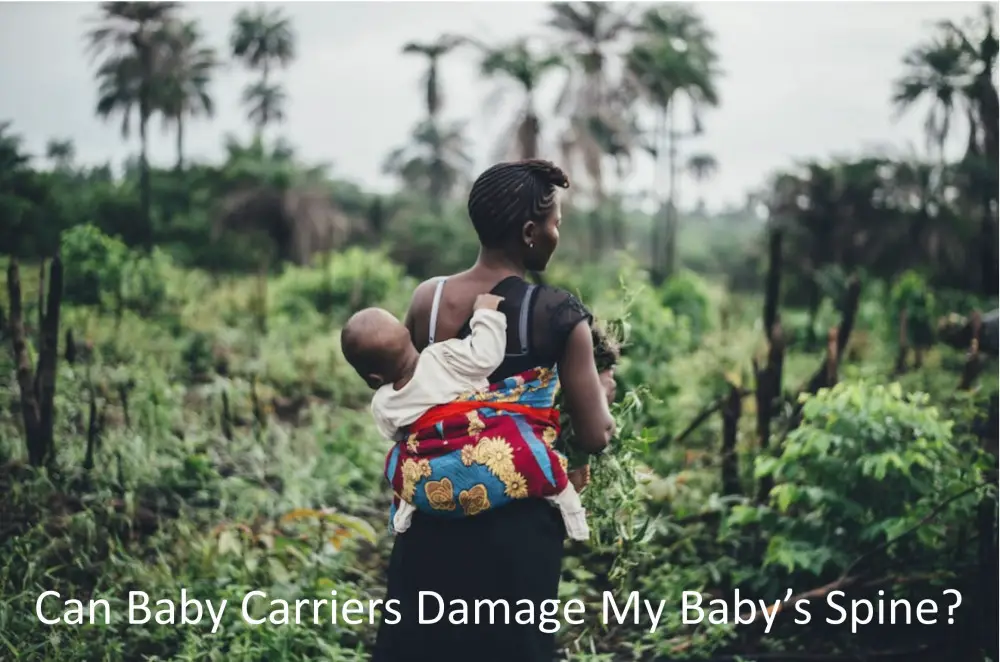Can Baby Carriers Damage My Baby’s Spine? (3 Facts You Must Know)

It is a common belief that the best position for a baby’s spine is when the baby is flat on its back.
But is that rightly so?
After all, the baby’s spine isn’t straight!
In fact, it is curled up in a C-shape.
Therefore, stretching the baby up on a flat surface seems to be quite stressful for the spine and hips. And frankly speaking – unhealthy.
How about baby carriers, though? Are they a better option for promoting healthy back development?
Since there is a lot of debate about baby carriers, allow me to clear your doubt about the effect baby carriers may have on your baby’s spine.
Can Baby Carriers Damage My Baby’s Spine?
It all depends, but generally speaking, if fitted well to the size, weight and development stage of your baby, and used in the correct baby-carrying position, an ergonomic baby carrier shouldn’t cause any damage to your baby’s spine. Quite the opposite. With the right leg support, babies carried around upright in the back-facing baby carrier are in the most optimal position for healthy physical and emotional well-being.
You Must Maintain the Natural Curvature Of Your Baby’s Spine
Have you noticed that your baby’s natural position is curled up, head down, arms and legs pulled in closed to their body?
And when you lift them up, they immediately bend their knees and spread their thighs in readiness to be carried on your body?
Sounds familiar, huh?
That’s because babies hang out in this position for most of their time in the womb and right after birth. It’s the so-called fetal position.
Moreover, babies or even adults associate this position with comfort, self-soothing, and safety. And that’s the exact position you want to maintain when carrying your baby in a carrier. In their most natural C- shaped alignment with good neck and leg support. Simple as that.
And this can be only achieved if you place your baby chest-to-chest (or back facing) and not the other way around.
As such, it is perfectly okay to carry your baby in a baby carrier from day one!!!!
In this super-comfy, frog-like position, your baby’s hips are spread open to the side, hips and knees bent, and the bottom is at the lowest to knees and hips.
Such an ergonomic seated M-shape allows the baby to move their hips freely and enables their joints to be held at the most optimum angles, which promotes healthy development.
And that’s the position you should carry your baby to guarantee the development of their spine is intact.
But there is more to it.
When you hold your baby upright in a carrier, they are literally glued to your body.
This means that they move together in sync with you. So, if you turn your body, walk, stop, reach out to grab something etc. your little one moves back and forth, side to side, in response to your movement.
These varied movements force your baby to adjust their body so that they can stay upright and keep their balance.
And that’s how babies can gain more muscular strength, practice fine motor skills and get better head control.
Can you see how beneficial and totally unharmful babywearing in an ergonomic carrier is to your little bundle of joy?
Humm, but my carrier allows carrying a baby in the front-facing position. This sounds fun! My baby can explore the world from a different perspective, right?
Well, this depends if your baby can hold their head up and is developmentally ready to process the sensory–overloaded environment they will be exposed to when “facing the world”.
This position is definitely not appropriate for newborns but for older babies. In fact, it can be more harmful than you may have thought…
Why Should I Not Carry My Newborn Baby Facing Out?
Because in this position, their legs are not sufficiently supported, and their centre of gravity is off and further to that of the adult.
Moreover, their legs are stretched loosely in extension with their hips. This means that their body weight is supported at the base of their spine.
Ultimately, this puts too much stress on their spine and hips, shoulders and chest…
You must avoid putting pressure on your baby’s spine!
In other words, carrying a baby in a front-facing position stretches their naturally curved back because of a lack of abdominal muscles and leg support.
This means that it is actually the unhealthiest position for your newborn baby can be in and can contribute to abnormal hip development or even hip dysplasia.
(Not to mention that it’s easier for you to carry a baby clinging to your chest than a baby sitting in an outward-facing position.)
It’s also worth noting that many baby carriers are designed to carry babies in multiple positions forward, side, and back-facing.
But.
Any reputable manufacturer will explicitly state that the front-facing position is only appropriate for older babies – those who have good head control. Before they reach this milestone, babies are not developmentally ready to be carried in this position, especially for longer than 30 minutes at a time.
How to properly use a baby carrier
Final Few Lines
Do you want your baby’s spine to grow strong?
Then don’t put any pressure on their tiny developing backs!
This means don’t stretch them out unnecessarily.
Babies love to be curled up, and that’s their natural position.
It will take time for them to “unfold” and develop the muscles to allow them to hold their heads up.
So, don’t straighten out your baby by carrying them in the front-facing carriers. You can harm their spine!
Instead, use a high-quality ergonomic baby carrier in the back-facing position that allows your baby to stay in their natural curled-up position without putting an unnecessary strain on their backs, with good head and leg support.
Related Post ==========>Why Do Babies Have To Lie Flat Until 6 Months?
